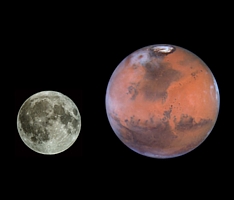As you can see, in 2006 (and every year without Martian opposition), the differences are more drastic. I repeat that the approaches have no relation to Jupiter's gravity, which does not alter or distort the Martian orbit; they occur when the Earth "reaches" Mars. slide 4, mentions: "at a modest magnification of 75"; this phrase does not really mean anything, but I assume it was meant to say that Mars could be seen with telescopes as small as 75 mm in diameter, which is true, but it is a very vague piece of information for someone unfamiliar with it and tends to be confusing. And the slide 6, mentions: "it will reach its azimuth around 3 am"; this phrase is also difficult to understand due to a conceptual error: azimuth is the angle above the horizon formed by a cardinal point and the vertical projection of the star on the horizon; what was meant in the powerpoint was culmination, which is the highest point that a star can reach above the horizon.
Mars the size of the Moon?
 I chose to leave the most scandalous error in the powerpoint for last. Distances in astronomy are very large and except for the Sun and the Moon (one is very large, and the other is very close), we only see almost all other stars as bright points with the naked eye. At no approach could Mars be so close to Earth as to be the size of a full Moon; the closest proximity (during perihelion) is ~55 million kilometers; at that distance, the largest we can see the red planet (as occurred in the 2003 opposition) will be with an apparent size of 25 seconds of arc, in contrast to the 14 seconds of arc usual that he presents when he is not in opposition.
I chose to leave the most scandalous error in the powerpoint for last. Distances in astronomy are very large and except for the Sun and the Moon (one is very large, and the other is very close), we only see almost all other stars as bright points with the naked eye. At no approach could Mars be so close to Earth as to be the size of a full Moon; the closest proximity (during perihelion) is ~55 million kilometers; at that distance, the largest we can see the red planet (as occurred in the 2003 opposition) will be with an apparent size of 25 seconds of arc, in contrast to the 14 seconds of arc usual that he presents when he is not in opposition.
The full Moon, on the other hand, occupies 31 minutes of arc, forks 132 times larger than Mars under normal conditions; during a Martian opposition the Moon is 72 times larger, so the difference is practically negligible. All this considering that the Moon has a diameter of 3,475 km, and Mars has 6,794 km.
What if it really happens?
Finally, for those who still have the illusion of seeing Mars so big with the naked eye, I tell you: if Mars really looked the size of the full Moon, it would mean that it left its orbit, it would be only 700,000 km away, and it would fall on us! ????

